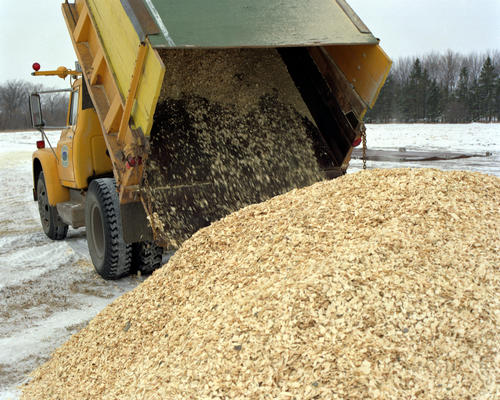Using wood and wood waste

People have used wood for cooking, heating, and lighting for thousands of years. Wood was the main source of energy for the United States and the rest of the world until the mid-1800s. Wood continues to be an important fuel in many countries, especially for cooking and heating in developing countries.
In 2021, about 2.1% of U.S. annual total energy consumption was from wood and wood waste—bark, sawdust, wood chips, wood scrap, and paper mill residues.1

Hybrid poplar wood chips being unloaded in Crookston, Minnesota
Source: National Renewable Energy Laboratory, U.S. Department of Energy (public domain)
Using wood and wood waste
Industry accounts for the majority of wood and wood-waste fuel consumption in the United States. The largest industrial users are wood products and paper manufacturers. They use lumber mill and paper mill waste to produce steam and electricity, which saves money because it reduces the amount of other fuels and electricity they purchase to operate their facilities. In 2021, wood and wood waste accounted for about 5.2% of industrial end-use energy consumption and 4.2% of total industrial energy consumption.2
The residential sector is the second-largest user of wood for energy in United States. Wood is used in homes throughout the United States for heating as cord wood in fireplaces and wood-burning appliances, and as pellets in pellet stoves. In 2021, wood energy accounted for about 4.0% of residential sector end-use energy consumption and 2.2% of total residential energy consumption. In 2020, wood was used as an energy source (mostly for space heating) in about 10.8 million homes, or by 8.8% of all U.S households About 2.2 million households used wood as the main space heating fuel.3
In the electric power sector, there are several power plants that burn mostly wood to generate electricity, and there are some coal-burning power plants that burn wood chips with coal to reduce sulfur dioxide emissions. Most of the commercial sector’s use of wood is for heating.
- The amounts—in trillion British thermal units (TBtu)—of wood and wood waste energy consumption by consuming sectors and their percent shares of total U.S. wood and wood waste energy consumption in 2021 were:
- industrial1,342 TBtu64%
- residential464 TBtu22%
- electric power199 TBtu10%
- commercial83 TBtu4%
2 End-use energy consumption includes primary energy consumption plus retail electricity sales. Total energy consumption includes end-use consumption plus electrical system energy losses
3 Residential Energy Consumption Survey 2020, Housing Characteristics, Table HC1.1
Last updated: June 2, 2022, with most recent data available at the time of update; data for 2021 are preliminary.
Courtesy of EIA Gov
